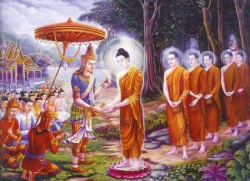Theravada Buddhism "The Teaching of the Elders" By Barbara O'Brien
Theravada is the dominant form of Buddhism in southeast Asia, and for this reason it is sometimes called the "Southern School." It claims about 100 million adherents worldwide. Its doctrines are taken from the Tripitaka , and its basic teachings begin with the Four Noble Truths.
Above all, Theravada emphasizes insight gained through critical analysis and personal experience rather than blind faith. Theravada is distinctive from the other major school of Buddhism, Mahayana, in several ways. Individual Enlightenment
Theravada emphasizes individual enlightenment; the ideal is to become an arhat (sometimes arahant), which means "worthy one" in Pali. An arhat is a person who has realized enlightenment and freed himself from the cycle of birth and death.
Beneath the arhat ideal is an understanding of the doctrine of anatman -- the nature of the self -- that differs from that of the Mahayana. Very basically, Theravada considers anatman to mean that an individual's ego or personality is a fetter and delusion. Once freed of this delusion, the individual may enjoy the bliss of Nirvana.
Mahayana, on the other hand, considers all physical forms to be void of intrinsic self and individual autonomy to be a delusion. Therefore, according to Mahayana, "individual enlightenment" is an oxymoron. The ideal in Mahayana is to enable all beings to be enlightened together. Self-Power
Theravada teaches that enlightenment comes entirely through one's own efforts, without help from gods or other outside forces. Some schools of Mahayana emphasize this also, but others (for example, Pure Land) are more devotional. Literature All schools of Buddhism recognize the Tripitaka as scripture. However, there are several sutras (sometimes collectively called the "Northern Canon" or "Mahayana Canon") that are essential to Mahayana but not considered legitimate by Theravada. Pali Versus Sanskrit
Theravada Buddhism uses the Pali rather than the Sanskrit form of common terms; for example, sutta instead of sutra; dhamma instead of dharma. Meditation
The primary means of realizing enlightenment in the Theravada tradition is through Vipassana meditation. Vipassana emphasizes disciplined self-observation of body and thoughts and how they interconnect. Some schools of Mahayana also emphasize meditation, but other schools of Mahayana do not meditate.
